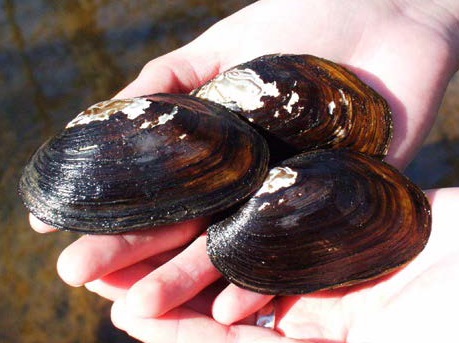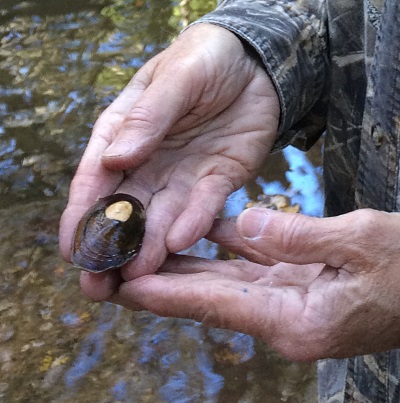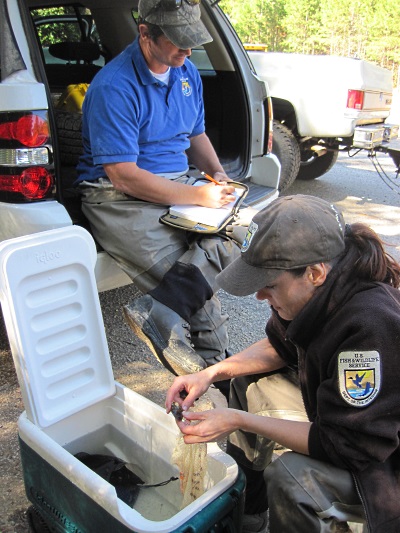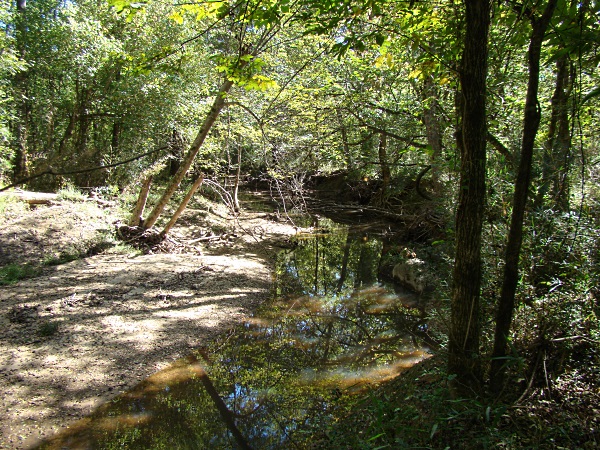Wildlife - Species

Status in SC: Threatened
Carolina Heelsplitter
This is currently the only mussel species in South Carolina that is federally listed as Endangered. It is also listed by the State of South Carolina as Endangered. NatureServe (2011) identifies the Carolina Heelsplitter as critically imperiled globally (G1) and statewide (S1) in both South Carolina and North Carolina (G1 and S1).
Additional Status Information on Carolina Heelsplitter in SC



Carolina Heelsplitter (Lasmigona decorata)
Description
The shape of the Carolina Heelsplitter's shell is an ovate trapezoid with a straight dorsal margin that may end with a slight wing. The outer surface of the shell is yellowish, greenish, or brownish and may have greenish or blackish rays. The inner shell surface ranges from iridescent white to mottled pale orange. The Carolina Heelsplitter shell can reach up to 118 mm (4.7 in.) in length; the mean shell length for this species is 78mm (3.1 in.) (Bogan and Alderman 2004, 2008).
Population Size and Distribution
In 1987, this species was rediscovered as it had not been found in its historic range since the mid 1800s (Taxonomic Expertise Committee 2004). The Carolina Heelsplitter has been reduced to only 8 surviving populations, 2 in North Carolina and 6 in South Carolina.
Turkey Creek and its tributaries, Mountain Creek, and Beaverdam Creek contain one population of Carolina Heelsplitters; these creeks are in the Savannah River drainage in Edgefield County. A smaller population is present in Cuffeytown Creek in Greenwood and McCormick Counties. In Lancaster County, the Lynches River and one of its tributaries, Flat Creek, also contain a population of Carolina Heelsplitters. A fourth population occurs in a very small stretch of the Gills River in the Catawba drainage (USFWS 2002). Two populations were recently discovered: one in Fishing Creek in Chester County, South Carolina (J. Alderman pers. comm.); and one in Bull Run Creek, also in Chester County (L. Zimmerman, pers. comm. e-mail message June 1, 2005). North Carolina populations are found in the Pee Dee and Catawba River drainages. The North Carolina population that is present in Waxhaw Creek is located within a few miles of the North Carolina/South Carolina border. The entire extent of the Heelsplitter's historic range is not known, but evidence indicates that it was once more widely distributed in the Catawba, Pee Dee, Savannah and, possibly, the Saluda River systems (USFWS 1997). The Carolina Heelsplitter has a spotty distribution where it is found due to restrictions in suitable habitat (USFWS 1997). Where the Carolina Heelsplitter is found, it is no longer abundant; typically only 1 to 3 individuals are discovered during a survey at any one site (Taxonomic Expertise Committee 2004). Droughts in recent years (2008, 2011) have impacted the known populations and some are surviving marginally or have possibly been extirpated. The only remaining population showing signs of recent reproduction is in Flat Creek (Morgan Wolf, USFWS pers. comm. 2011).
Habitat and Natural Community Requirements
Although it was once found in large rivers and streams, the Carolina Heelsplitter is now restricted to cool, clean, shallow, heavily shaded streams of moderate gradient. Stable streambanks and channels, with pool, riffle and run sequences, little or no fine sediment, and periodic natural flooding, appear to be required for the Carolina Heelsplitter (USFWS 2002). Although the Carolina Heelsplitter is found in some degraded streams, such as Waxhaw Creek, it appears to be restricted to the highest quality portions of those streams (Taxonomic Expertise Committee 2004).
Challenges
The Carolina Heelsplitter is vulnerable to a variety of threats related to human disturbance. Polluted wastewater from sewage treatment plants and industrial discharges are a threat. Storm water runoff carrying silt, fertilizer, pesticides, and other pollutants threatens the Carolina Heelsplitter, especially when erosion and stormwater control is inadequate (USFWS 2002). Habitat alteration including impoundments, channelization, dredging, and streambank scouring by stormwater runoff have also contributed to the decline of the Carolina Heelsplitter and adversely affect remaining populations (USFWS 2002). Activities such as agriculture, forestry, road construction, mining, urban development, and other land use activities that do not adequately control stormwater runoff and soil erosion are likely to destroy Carolina Heelsplitter habitat (United States Fish and Wildlife Service 2002). Given current rates of growth and development in the upper Lynches River watershed, all of the northern populations of the Carolina Heelsplitter are in danger of being lost in a few decades if nothing is done to reduce the rate of development and minimize the impact of development on this endangered species (Taxonomic Expertise Committee 2004).
Conservation Accomplishments
The United State Fish and Wildlife Service (USFWS) (1997) has created a Recovery Plan for the species that includes objectives such as research and monitoring of existing populations, reintroduction programs, and public education. They have also designated stretches of streams where the Carolina Heelsplitter is found as critical habitat (USFWS 2002). They have proposed that the establishment of sanctuaries, stream buffer zones and other protective measures should be encouraged. Recent work has shown a number of relatively common stream fishes serve as suitable hosts for the Carolina Heelsplitter (Eads et al. 2010). Propagation efforts have been attempted but little has been done with this species to date; however, propagation of other more common species has shown promising results in recent years. The population genetics of the species have been studied, and such information allows decisions to be made regarding the movement of propagated individuals across drainage divides.
Conservation Recommendations
Partner with United States Fish and Wildlife Service to carefully evaluate the impact of all potential development projects proposed in the watersheds where the Carolina Heelsplitter is found.
Encourage careful land use planning in the Charlotte metropolitan area to protect the upper Lynches River and Catawba River watersheds. Land protection through conservation easements and fee simple purchases should be a high priority, especially in the vicinity of Fishing Creek and the headwater streams in the upper Lynches River drainage. Land protection is also necessary in the Steven's Creek Basin, particularly around headwater streams. Careful land use planning is necessary in the Augusta and Aiken developing areas that are beginning to encroach upon this watershed. Such protection may be accomplished through conservation easements or fee simple purchase.
Protect critical habitats for the Carolina Heelsplitter from future development and further habitat degradation by following Best Management Practices.
Promote land stewardship practices through educational programs both within critical habitats with healthy populations and in other areas that contain available habitat for the Carolina Heelsplitter.
Consider this species' needs when participating in the environmental permit review process.
Educate off-road motor vehicle operators of the negative effects of crossing streams at multiple locations and using stream bottoms as trails.
Measures of Success
An increase in the size of the remaining populations of the Carolina Heelsplitter will indicate success of management practices. The ability to propogate the species successfully and reintroduce or establish new populations will decrease the likelihood of extinction.
November 3, 2015 - DNR assists in stocking endangered freshwater mussel
November 3, 2015 - Rainbow Ranch Tract: Now part of Forty Acre Rock
References
Bogan, A.E. and J.M. Alderman. 2004. Workbook and key to the freshwater bivalves of South Carolina. i–ii + 1–64 pp. + 5 pls.
Bogan, A.E. and J.M. Alderman. 2008. Workbook and key to the freshwater bivalves of South Carolina (Revised Second Edition). i–ii + 1–66 pp. + 5 pls.
Eads, C.B., R.B. Bringolf, R.D. Greiner, A.E. Bogan, and J.F. Levine. 2010. Fish hosts of the Carolina heelsplitter (Lasmigona decorata), a federally endangered freshwater mussel (Bivalvia: Unionidae). American Malacological Bulletin 28(2): 151–158.
NatureServe. 2011. NatureServe Explorer: An online encyclopedia of life [web application]. Version 7.1. NatureServe, Arlington, Virginia. Available http://www.natureserve.org/explorer.
United States Fish and Wildlife Service (USFWS). 1997. Recovery plan for Carolina Heelsplitter (Lasmigona decorata) Lea. U.S. Fish and Wildlife Service. Atlanta, Georgia. i–v + 1–30 pp.
United States Fish and Wildlife Service (USFWS). 2002. Endangered and threatened wildlife and plants: designation of critical habitat for the Carolina heelsplitter. Federal Register 67(127) [July 2, 2002]:44502-44522.
